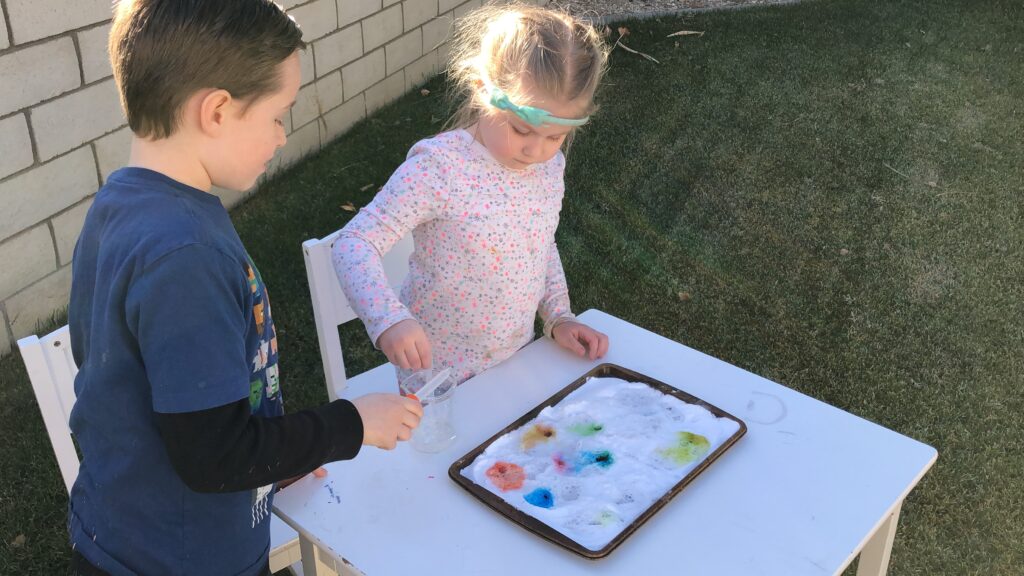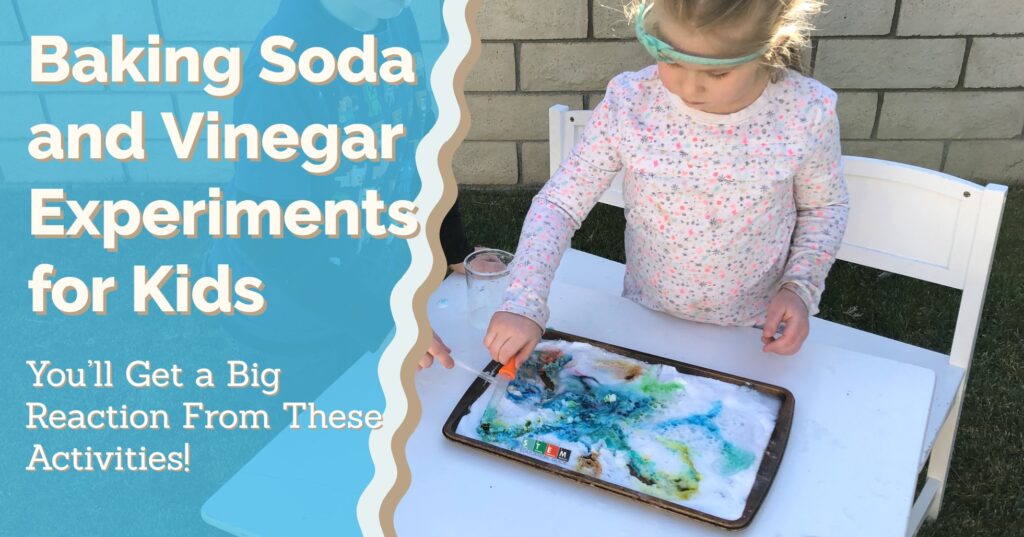One of the simplest but satisfying DIY science experiments is the baking soda and vinegar reaction.
From volcanoes to bottle rockets, this experiment packs a punch. Fun for kids (and adults) of all ages, the baking soda, and the vinegar experiment are fun ways to learn about chemical reactions.
Table of Contents
How Baking Soda & Vinegar Reaction Works – a Simple Explanation
When baking soda and vinegar come together, a chemical reaction occurs. Chemical reactions are a process where two different things come together to make something new.
In this chemical reaction baking soda and vinegar make bubbles of carbon dioxide gas. The chemical reaction is what makes the mixture fizz.
How The Reaction Works – A Complex Explanation
Baking soda and vinegar experiments are an endothermic, acid-base reaction. Baking soda is the base, and vinegar is the acid.
What’s a Base:
In chemistry, a base is a chemical species which donates electrons, takes protons, or releases hydroxide (OH-) ions in an aqueous solution. Bases display specific characteristic properties which may be utilized to help identify them. (Definition from ThoughtCo.com)
They are usually slippery to the touch (e.g., soap), may taste bitter, react with acids to form salts, and catalyze particular reactions.
What’s an Acid:
An acid is a chemical species which donates protons or hydrogen ions and/or takes electrons. Most acids have a hydrogen atom ensured that may discharge (dissociate) to give a cation and an anion in water.
The higher the concentration of hydrogen ions generated by an acid, the greater its acidity and the lower the pH of the solution. (Definition from ThoughtCo.com)

When baking soda and vinegar are mixed, it releases an unstable substance called carbonic acid. The carbonic acid breaks down into carbon dioxide gas and water. As the gas quickly leaves the water, the substance fizzes.
The process is endothermic, which means the reaction absorbs heat from its’ environment. This energy is what activates the chemical reaction. Endothermic reactions are cold, which is why the baking soda and vinegar mixture becomes cold to touch.
Kids Science Activity With Baking Soda and Vinegar
Now that we have the reason for the reaction with baking soda and vinegar, let’s get into the fun part, science experiments!
Easy Baking Soda and Vinegar Reaction

This first one will be very straight forward with only a few things needed. Your basically just mixing the chemicals together with different ratios each time and documenting with ratio gives the biggest reaction.
Supplies Needed
Here is what you will need for a successful baking soda and vinegar reaction:
- Baking Soda. (This is a big bag of baking soda we used from Amazon)
- White Vinegar. (This is the bottle of White Vinegar we used fro Amazon but you should be able to find it easy at a supermarket too)
- A Container (I.E., a plastic bottle or a water cup)
- Food Coloring (optional, but it can add fun to the experiment. Using different food colorings (Amazon link) is a great way to compare experiments). You can also find this at just about any supermarket as well.
- Table Spoon or Measuring Cup (this will depend on your container’s size and how big of a reaction you want to see).
Step By Step Process
Now, here’s how you do it:
Step One
Fill your container with baking soda. If your container is on the smaller side, I recommend one tablespoon of baking soda.
If you are using a large container, you could add more baking soda. Experiment with different amounts to find out what creates the most fizz.

Step Two
Now, you’ll need to add vinegar. The more vinegar, the more explosive the reaction (unless you add TOO much).
A 12 to 1 ratio of vinegar to baking soda is a good place to start. So, if you used one tablespoon of baking soda, add 12 tablespoons of white vinegar.
Step Three
Watch your creation fizz and bubble! Try experimenting with different ratios of vinegar and baking soda to add to the learning experience.
Notice the reaction times of the baking soda and vinegar when you change the amounts used. How are they similar? How are they different?

Rainbow Baking Soda and Vinegar Experiment

This experiment was more for my five-year-old daughter but it turned out my eight-year-old son loved it too.
I thought this one was going to get a little messy so we took it outside. It’s also a good idea if your kids are in play clothes just in case they get a little wild with this STEM experiment.
Supplies Needed
If you’re already going to have everything out from doing the basic experiment from above you might as well do this one too; my kids loved this one!
- Baking soda & Vinegar (of course right!?) (Both links go to Amazon)
- A baking sheet to spread the baking soda. A baking sheet works well.
- Food coloring.
- A small dropper like this one from Amazon, bright color droppers.
- This is optional because we wanted to see how half the baking sheet would react with Pure Citric Acid. (Amazon link)
Step One
Fill the baking tray up with baking soda. Make sure to put a smooth layer covering the pan evenly.

Step Two
Add droplets of food coloring in different spots. Use different colors to surprise your kids when doing to experiment.

Step Three
Use a thin layer of baking soda to cover up the food coloring droplets. This layer doesn’t need to be that thick.

Step Four
Take the baking sheet outside or in a safe area, use the dropper with vinegar to find the area with the food coloring. Kids will find it fun to discover where the different colors are on the baking sheet hiding in the baking soda.


Baking Soda and Vinegar Balloon Experiment

This is another fun chemistry science experiment kids will love! Watching a balloon fill up from a chemistry got a big reaction from my kids.
Supplies Needed
- A plastic bottle. We used a water bottle, (16oz).
- Baking Soda & Vinegar (Amazon links). A 12 to 1 ratio of vinegar to baking soda is a good place to start.
- A balloon of any color.
- A funnel to easily fill the ballon with baking soda.
Step One
Use the funnel to add baking soda inside the balloon. We also tried it the other way of filling the balloon with vinegar but the kids spilled some vinegar that way.

Step Two
Fill the plastic bottle with vinegar.

Step Three
Secure the lip of the balloon on the top of the plastic bottle. Make sure not to spill any of the baking soda in the bottle yet or the chemical reaction will happen before you fully secure the balloon.
My kids had a bit of trouble getting the balloon on so you’ll have to help with this step.

Step Four
Tilt the baking soda inside the balloon into the bottle of vinegar!

If you’d like to check out another fun kids’ chemistry experiment, click to see our, Exploding Colors Experiment with Baking Soda & Vinegar. Also, our 6 Simple Chemistry Experiments for Kids That You Can Do at Home.
Baking Soda Rocket

This is a fun one my kids really enjoyed. You can see when the rocket took off, and it caught them off guard.
You can build a rocket from stuff you have at home already, but we decided to buy a kit with the rocket already. If you want to check out the baking soda rocket kit, we ended up getting, you can follow this link to see the current price.
The kit will come with instructions but you’re going to set your base on solid grown, away from anything you don’t want messy.
Put vinegar in the bottle. Then add the baking soda. Quickly push the cork down into the opening. Set the rocket down, and a few seconds later, the rocket will take off.

Safety Tips
Remember to use basic safety precautions when trying this experiment. At large amounts, this can be somewhat explosive (in a good way). If you have limited space, try using smaller amounts of each substance.
If you are trying for a HUGE reaction, go outside. Eye protection is highly recommended when performing this experiment, especially at high volumes.
Don’t stand directly over the container – make sure to keep your distance. Have plenty of towels and clean up supplies ready to go.
Questions and Answers About Mixing Baking Soda and Vinegar Together
What Happens When You Mix Vinegar and Baking Soda Together?
When you mix baking soda and vinegar, a chemical reaction occurs. The chemical reaction creates carbon dioxide gas, which causes the mixture to fizz.
What Affects the Rate of the Baking Soda and Vinegar Reaction?
Temperature will affect the rate of the baking soda and vinegar reaction. Higher temperatures will cause a faster reaction, while colder temperatures will cause a slower reaction.
Does Baking Soda and Vinegar Get Hot?
No, baking soda and vinegar will actually get cold. This is because it is an endothermic reaction, which consumes energy.
What Is the Chemical Reaction of Vinegar and Baking Soda Called?
The chemical reaction of vinegar and baking soda is called an acid-base reaction. When an acid (vinegar) is combined with a base (baking soda), it creates something new (carbon dioxide gas).
Wrapping Up
We like that these are simple and relatively mess free science experiments you can do at home. There’s a ton of ways of mixing baking soda and vinegar together, but let us know what you and your family found to be the best way down in the comments!








